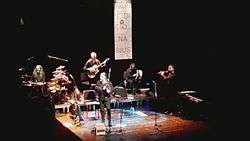Luar na Lubre
| Luar na Lubre | |
|---|---|
|
Luar na Lubre | |
| Background information | |
| Origin | A Coruña, Galicia, Spain |
| Genres | Galician music, Celtic music, folk music |
| Years active | 1986–present |
Luar na Lubre is a Celtic music ensemble from Galicia, Spain.
Etymology
Luar is Galician for moonlight; lubre is a magical forest in which the Celtic druids cast their spells.
Biography
During its career, this musical group has spread Galician music and culture. The band became famous worldwide after Mike Oldfield took interest in their music. Oldfield fell in love with their song "O son do ar" (The sound of the air, composed by Bieito Romero). Oldfield's cover is on his Voyager album, entitled "Song of the Sun". In 1992 he offered help in their worldwide tour. Their tour together was called Tubular Bells 3.[1] Now it is one of the most famous groups from Galicia. Their first singer Rosa Cedrón is also featured with Mike Oldfield in some songs from his live concert at Horse Guards Parade, near St James's Park, London. Rosa Cedrón left the band in 2005 and Sara Vidal became the new singer. In 2010, the group's leader, Bieito Romero, said the group was "fully fit".[2]
The group recorded a version of Gerdundula by Status Quo.
The Spanish folk metal band Mägo de Oz made a cover of Luar na Lubre's song "Memoria da Noite."
Their most famous singles are "Memoria da Noite", "Os Animais", "O son do ar", "Tu gitana" and "Chove en Santiago". Most of their lyrics are in the Galician language. Their song "Nau", written by Bieito Romero is about Galicia as a ship with no direction.[3]
The song "Downstream" by Shira Kammen on her album "Music of waters" appears to have used its own cover of "O son do ar" in a segment of the song. Kammen's cover appears in Braid (video game).
Members
- Current members
- Paula Rey – Vocals
- Xulio Valera – Bouzouki, vocals and percussion
- Bieito Romero – Bagpipes, accordion and zanfoña
- Eduardo Coma – Fiddle
- Patxi Bermudez – Bodhran, drum and djembe
- Pedro Valero – Acoustic guitar
- Xavier Ferreiro – Latin percussion and effects
- Xan Cerqueiro – Flutes
- Former members
- Ana Espinosa – Vocals
- Daniel Sisto – Acoustic guitar
- Rosa Cedrón – Vocals (1996–2005)
- Sara Louraço Vidal – Vocals (2005–2011)
- Xavier Cedron – Fiddle
- Xulio Varela – Bouzouki, horn, tarrañolas and tambourine
- Wafir Gibril – Ud
Discography
- Extra: Mundi (2015)
- Torre de Breoghán (2014)
- Sons da lubre nas noites de luar (2012)
- Mar Maior (2012)
- Solsticio (2010)[2]
- Ao vivo (2009)
- Camiños da fin da terra (2007)
- Saudade (2005)
- Hai un paraiso (2004)
- Espiral (2002)
- XV aniversario (2001)
- Cabo do mundo (1999)
- Plenilunio (1997, re-issued 2002 with bonus live tracks from 2000)
- Ara Solis (1993)
- Beira atlántica (1990)
- O son do ar (1988)
References
- ↑ Labanyi, Jo (2002). Constructing identity in contemporary Spain: theoretical debates and cultural practice. Oxford University Press. p. 343. ISBN 9780198159933. Retrieved 2010-05-24.
- 1 2 "Luar Na Lubre – Solsticio (Spain 2010) @320". Folk Yourself. 24 March 2011. Retrieved 17 July 2011.
- ↑ Romero, Eugenia R. (2006). "Amusement Parks, Bagpipes, and Cemeteries: Fantastic Spaces of Galician Identity through Emigration". Journal of Spanish Cultural Studies. 7 (2): 155–169. doi:10.1080/14636200600811177.
